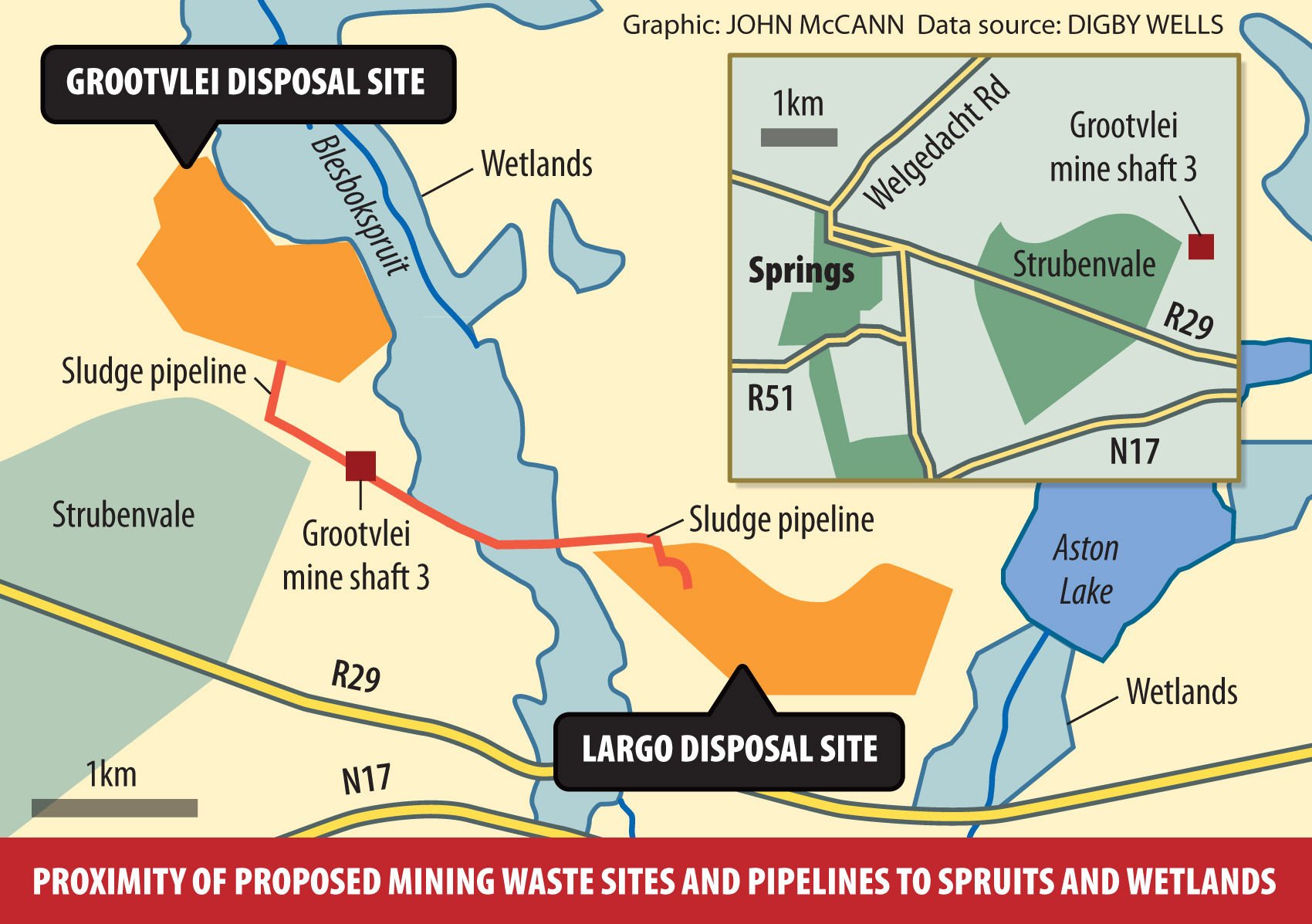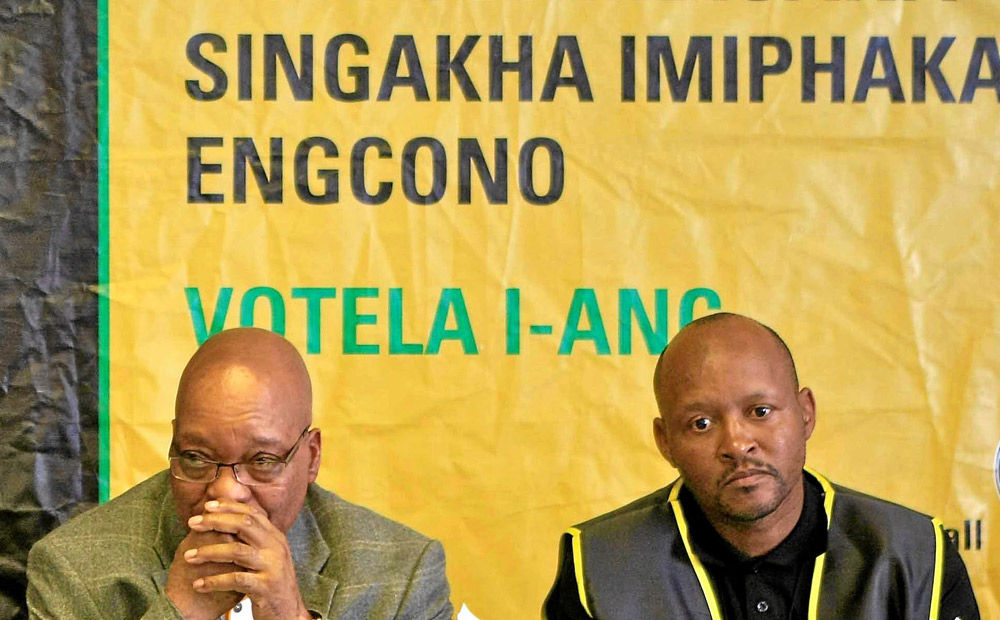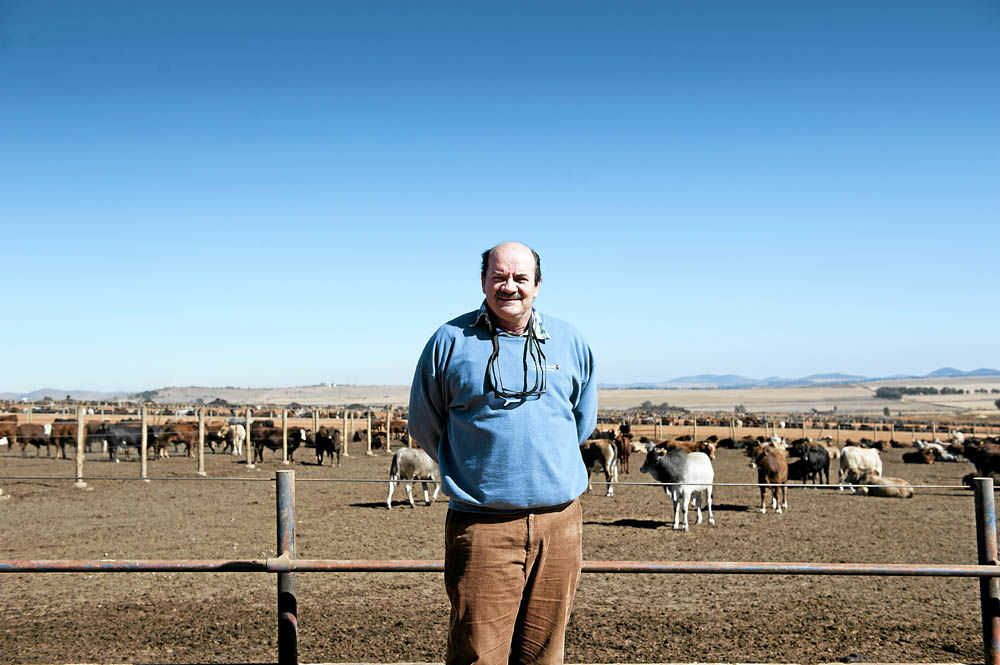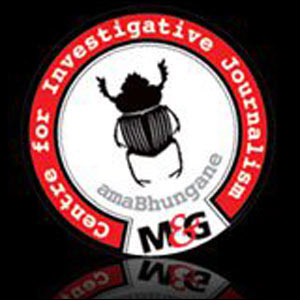Acid mine drainage could seep into dams and rivers
The government is forging ahead with a R1-billion project for the treatment of acid mine drainage in Ekurhuleni – despite a fierce backlash by residents and environmental experts over the millions of cubic metres of toxic, and possibly radioactive, sludge the project will churn out.
More than 1 000 residents have signed a petition against the siting of the treatment plant at the Grootvlei mine’s number three shaft, about 5km from the centre of Springs, which forms part of the Ekurhuleni Metropolitan Municipality on Johannesburg’s East Rand.
A spokesperson for the residents warned that the plant could render the area uninhabitable and described the government as “mad” for locating it there.
At the same time, a prominent environmentalist has pointed to the dangers of seepage into a residential and farming area with an already fragile ecosystem.
Water affairs department spokesperson Sputnik Ratau conceded there had been “public resistance” during the environmental impact assessment process. But he also said construction and pumping would go ahead despite the backlash, after the environmental affairs minister granted authorisation under environmental law for emergency works.
The contract was awarded last month to the CMC/PG Mavundla Engineering Eastern Basin joint venture for a price of R956-million.

Short term measure
The scheme is a short-term stabilisation measure to head off the worsening acid mine drainage (AMD) crisis in the eastern basin of the Witwatersrand, a 768km2 “mine residue area” that includes agricultural land and highly populated centres such as Benoni, Brakpan, Springs and Nigel.
It will comprise a neutralising plant for the AMD, a pump station, underground pipelines and a 14m-high facility to store 1.75-million cubic metres of high-density sludge, to be extracted over a maximum of eight years. Construction will take about 18 months.
Because it is hygroscopic – that is, it draws water from the atmosphere – the toxic sludge will remain in a permanently jellified form.
Once treated, the water will go back into the Blesbokspruit, part of the Vaal Barrage system, a national water resource. This has provoked major worries among downstream users, including South Africa’s largest beef-farming operation, Karan Beef near Heidelberg (see “Livelihoods under threat”).
AMD is the result of water flooding subterranean voids left by gold mining at disused mines where pumping has stopped, and becoming acidified by contact with pyrites. Apart from the risk of ground water being contaminated, the water can “decant” – break the surface – and pollute surface water bodies.
Threatened ecosystems
Decanting has already occurred in the western basin of the Witwatersrand around Krugersdorp.
Mariette Liefferink, chief executive of the Federation for a Sustainable Environment, said Springs residents have every reason to be concerned, as the high-density sludge to be extracted and stored will contain toxic and potentially radioactive metals including uranium, aluminium, lead, cadmium, manganese, iron, copper, cobalt and zinc.
Liefferink said that, according to her preliminary assessment, none of the nine sites earmarked for the disposal of metal sludge are suitable.
In a letter to Digby Wells Environmental – the company assessing the environmental impact for a longer-term AMD solution – she warned that the sites are close to the Blesbokspruit, whose “ecological status is already poor … additional stress on the system will be unacceptable”.
Liefferink said if the sludge is disposed of in an unlined facility or close to wetlands it could result in the seepage or movement of toxic material into ground water, soil, wetlands and surface water bodies. Without stringent controls, she believes it is almost certain that crop soils will be irrigated with contaminated surface or underground water.
She also warned of the risk to “ecosystem goods and services” on disturbed, fragmented or polluted properties, and of the potentially toxic impact that pollutants that have built up in animals and plants could have on human beings.
The treatment scheme could further reduce species diversity and irreversibly alter the ecosystem, Liefferink said, adding that the well-known Marievale Bird Sanctuary is also at risk.
Delays
In response, Ratau said the government had to address the AMD crisis, which it had inherited when it came to power in 1994.
Meanwhile, the water affairs department has come under fire for the two-year delay in awarding the construction tender, amid fears that AMD in the eastern basin will soon rise to the surface.
Ratau revealed that the department’s original intention was to hand out the contract in the last quarter of 2012, but that, “while awaiting approval of funding and the cost-recovery mechanism, the contract award was deferred”.
He conceded that acid water has already breached the “environmentally critical level” – a vital parameter for preventing the contamination of ground water systems – but said that the original measure had been “a conservative estimate based on information available in late 2010”. It could be gradually raised, subject to monitoring.
Responding to claims that the two-year delay could result in cost escalations and possible injuries to construction workers who will now have to work around the clock to catch up, Ratau said the contractor would have to follow a “fast-tracked schedule” to meet the revised level, but that this would not incur additional costs.
Nothing but spin
But Tony Turton, of the Centre for Environmental Management at the University of the Free State, said the delay indicates that, “while the government makes public statements that its commitment to the AMD solution is high, the reality is that it is low on the agenda”.
Turton said AMD had decanted into the western basin in 2002, and did so again this year. At its peak, 60‑million litres a day bubble to the surface at 18 Winze Shaft in Krugersdorp, he said. This water is now flowing into the Crocodile River, upstream of Hartbeespoort Dam, and the Mooi River, upstream of the Vaal River. It has already affected residents with boreholes, and “there is also a growing fear among rural communities that borehole water is contaminated”.
He said agriculture has also been affected in some areas. In particular, the Coetzee Dam has been heavily contaminated with uranium. “A farmer breached the wall to allow the trapped sediment to flow out, creating a uranium plume that entered the Potchefstroom drinking water system.”
According to research by North West University, uranium is moving into the food chain, Turton said.
“We know, with a high level of scientific confidence, that the western basin is an ecological disaster … we now see the rapid movement of highly contaminated water though the aquifer. The same will occur, with a reasonably high level of certainty, when the environmentally critical level is breached in any other mining basin, particularly if the aquifer is dolomitic.”
Turton rejected Ratau’s explanation that the critical level had been recalculated in the eastern basin, pointing out that nothing has changed in the rocks underground.
“The claim that the level has been redefined, simply to justify that a delay in the awarding of the Ekurhuleni contract will not cause any damage to the environment, is in my professional opinion nothing more than spin,” he said.
The absence of a clear government policy on mine residue areas poses “a growing risk to millions of people who are living on land that is increasingly geotechnically unstable and contaminated by uranium”, said Turton.
PG Mavundla Engineering project manager Philani Mavundla said that, given his experience with big government contracts, it was “humanly possible to complete the task before disaster could occur”.
In the longer term, a controversial proposal for the remediation of AMD envisages treating it to a potable level and using it to supplement Rand Water’s water supply in Gauteng.
This proposal apparently still awaits Cabinet approval.
Plant contractor denies closeness to Zuma
The winner of the R1-billion contract for the eastern basin acid mine drainage treatment project is also a key contractor in a giant hydroelectric scheme in KwaZulu-Natal. Its price has reportedly jumped threefold since its inception.
PG Mavundla, owned by flamboyant former Greytown mayor Philani Godfrey Mavundla, is part of the CMC Impregilo Mavundla joint venture that is building Eskom’s Ingula pumped storage electricity project in the Little Drakensberg, near Van Reenen’s Pass.
This week Eskom spokesperson Andrew Etzinger said the overall cost of Ingula now stands at R26‑billion. In 2012 Business Day reported that the initial cost of the project was a third of this amount, at R8.9‑billion.
On completion, originally set for later this year, it will be Eskom’s third-largest pumped storage scheme, with an output of 1 332 megawatts.
 President Jacob Zuma and Philani Mavundla in 2011. Photo: Tebogo Letsie/Gallo Images/The Times
President Jacob Zuma and Philani Mavundla in 2011. Photo: Tebogo Letsie/Gallo Images/The Times
The joint venture is responsible for the extensive works, including an underground power complex.
Business Day quoted construction industry sources as saying that Eskom cost overruns on Ingula seem abnormally high and are mainly related to claims from contractors.
Last week Mavundla said the cost of his company’s work at Ingula remained at R7‑billion, the amount tendered for.
He said: “Of the three power station projects currently under way, Ingula is the best; the work has been going very well there. Allegations that the cost has tripled are unfounded.
“I got the tender because I was the lowest bidder. Are you implying that the tender should have gone to someone who bid more?
“All the contracts I’ve been awarded I tendered for. For the [eastern basin] AMD project, too, I was the lowest bidder. I try to run my business as cleanly as I can.”
Mavundla is said to be close to President Jacob Zuma; in 2009 he made headlines when he slaughtered 20 cattle to celebrate Zuma’s rise to the presidency. However, he said the allegations of his closeness to the president “have been made before, but there is certainly no proof”.
Meanwhile, Eskom interim chief executive Collin Matjila revealed in a presentation on June 5 that the Ingula schedule has been significantly delayed by an accident in October, in which six construction workers were crushed to death by scaffolding.
Matjila indicated that the scheme will come on stream in the second half of next year.
Police spokesperson Colonel Jay Naicker said the police investigation into the accident has been completed. The docket has been sent to the office of the senior public prosecutor at the Ladysmith Magistrate’s Court for a decision on whether to prosecute. – Zwanga Mukhuthu
Livelihoods under threat
“The government has gone completely mad to think that they can come and start putting these facilities on our doorstep,” said Philip de Jager. “The project will render this area uninhabitable and have a vast impact on the local economy.”
De Jager was objecting to the water affairs department’s acid mine drainage (AMD) treatment scheme for the eastern basin. The construction project will now go ahead after the department finally awarded the contract and sidestepped environmental impact assessment requirements by invoking emergency provisions.
A lawyer who lives in Strubenvale, next to the Blesbokspruit, De Jager was speaking for residents who live and work around Springs suburbs such as Welgedacht, Aston Lake, Casseldale and Grootvlei agricultural holdings.
Speaking with passionate conviction, De Jager argued that the AMD project threatened the Blesbokspruit wetland, “the only Ramsar site in Gauteng”.
“In 1976, world authorities met in Iran and agreed that we all have to play a role in protecting wetlands of national importance. Wetlands are the lungs of the country. South Africa is the current vice-chair of the international Ramsar standing committee.”
He said that the pumping and treatment of AMD will inevitably result in toxic chemicals being released into the atmosphere. “This is potentially harmful and life-threatening, and will have a negative effect on our property values.
“We’ve been consulted by the independent environmental consultant, but we’re still opposed to the idea,” said De Jager.
 Karan Beef consultant Johan van Niekerk. Photo: Madalene Cronje
Karan Beef consultant Johan van Niekerk. Photo: Madalene Cronje
Opponents of the scheme say there is an alternative site for the disposal of the sludge at the Ergo dump, 4km south of Springs.
There is also concern among farmers who use the Blesbokspruit to water their livestock. They include Karan Beef, outside Heidelberg, which has Africa’s largest feedlot, capable of accommodating 120 000 animals. The company supplies 30% of South Africa’s beef.
Karan Beef’s environmental consultant, Johan van Niekerk, said the company is worried about high levels of sulphate that will be brought down the river once pumping starts.
Van Niekerk warned that, as water affairs will not be able to completely clean the water, users will have to pay for additional treatment before livestock can drink it, increasing operational costs. – Zwanga Mukhuthu
* Got a tip-off for us about this story? Click here.

The M&G Centre for Investigative Journalism (amaBhungane) produced this story. All views are ours. See www.amabhungane.co.za for our stories, activities and funding sources.